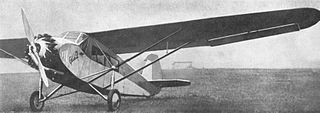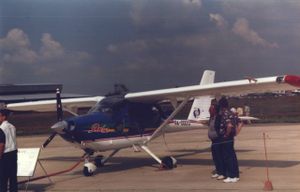
The Mikoyan-Gurevich MiG-8 Utka was a Soviet experimental aircraft. Built of wood, the aircraft was designed and built in 1945 to test the novel canard configuration. It also used a tricycle undercarriage, the first used by the OKB. It was modified to test a variety of vertical stabilizer and wingtip configurations and was later used as a liaison aircraft for many years by the design bureau.

The Yakovlev Yak-2 was a short-range Soviet light bomber/reconnaissance aircraft used during World War II. It was produced in small numbers, and most of them were destroyed during the opening stages of Operation Barbarossa.
The Yakovlev Yak-4 was a Soviet light bomber used during World War II. It was developed from the Ya-22/Yak-2.

The Yakovlev Yak-16 was a Soviet light transport that first flew in 1947. Prototypes were built in both passenger and military cargo versions, but neither was put into production as the Antonov An-2 was felt to be more versatile.

The Beriev Be-6 was a flying boat produced by the Soviet Beriev OKB. It was capable of accomplishing a wide variety of missions, such as long-range maritime reconnaissance, coastal and supply line patrols, torpedo/bombing strikes, mine-laying, and transport operations.

The Yakovlev Yak-30 was an experimental Soviet interceptor from the late 1940s. Derived from the Yak-25, from which it differed primarily in having wings sweptback 35° at quarter chord, the Yak-30 retained the fuselage, tail surfaces and undercarriage of the earlier fighter.

The Yakovlev Yak-6 was a Soviet twin-engined utility aircraft, developed and built during World War II. It was used as a short-range light night bomber and a light transport.
The Ilyushin Il-1 was a Soviet fighter aircraft developed during World War II by the Ilyushin design bureau. It was designed in 1943 as an armored fighter for use at low and medium altitudes against the latest German fighters, but by the time it made its first flight in 1944, the Soviets had already achieved air superiority and it was therefore redundant. Only one example was built, but the parallel two-seat attack version led to the successful Ilyushin Il-10.

The Yakovlev EG (Eksperimentalnyi Gelikopter), also commonly known as the Yak-M11FR-1 and Sh (Shootka), was an experimental aircraft with coaxial rotors. The prototype was first flown by V.V. Tezavrovsky in December 1947.
The Nikitin NV-1 was a single-seat sporting aircraft produced in the USSR in 1933.
The Yakovlev Yak-5 was an experimental trainer aircraft designed by Yakovlev OKB in the Soviet Union, and first flown in 1944.

The Stal-2 was a Russian mid-range passenger aircraft.
The Stal-11 was a high speed transport aircraft / reconnaissance aircraft designed and built in the USSR from 1933.
The LEM-3,, was a transport aircraft designed and built in the USSR from 1936.

The Yakovlev Yak-8 was a Soviet utility aircraft developed during World War II. It was not accepted for production, but received the NATO reporting name "Crib" anyway.

The Yakovlev Yak-200 was a prototype Soviet multi-engine trainer built during the 1950s. A modified version was built as the Yak-210 for navigator training, but only one example of each was built before the program was cancelled in 1956.

The Yakovlev Yak-140 was a Soviet prototype lightweight supersonic fighter developed during the 1950s. The prototype was completed in 1954, but it was denied authorization to enter flight testing and the program was cancelled in 1956.
The Yakovlev Yak-10 was a Soviet light liaison aircraft designed and built by the Yakovlev design bureau in the 1940s.
The Kalinin K-6 was a mail-plane designed by Konstantin Alekseevič Kalinin. It was an aircraft largely derived from the previous Kalinin K-5, which shared its wing, tail and landing gear. This aircraft differed from the previous one by the new fuselage design, which was slender and had a four-meter compartment for the load. The K-6 flew for the first time in 1930 but remained at the prototype stage, since mass production was never authorised.
The Kalinin K-10 was a monoplane designed by Konstantin Alekseevič Kalinin to perform liaison, training and agricultural tasks. From the technical point of view, it was characterized by the presence of tandem controls, fixed carriage, and folding wings, in order to make storage easier.











